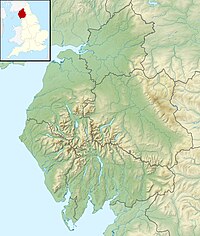Cross Fell
| Cross Fell | |
|---|---|

|
|
| Highest point | |
| Elevation | 2,930 ft (890 m) |
| Prominence | 2,136 ft (651 m) |
| Parent peak | Helvellyn |
| Listing | Hewitt, Marilyn, Nuttall, Hardy |
| Coordinates | 54°42′10″N 2°29′14″W / 54.70278°N 2.48722°WCoordinates: 54°42′10″N 2°29′14″W / 54.70278°N 2.48722°W |
| Geography | |
| Location | North Pennines, England |
| OS grid | NY687343 |
| Topo map | OS Landranger 91 |
Cross Fell is the highest mountain in the Pennine Hills of Northern England and the highest point in England outside the Lake District. It is located in the North Pennines Area of Outstanding Natural Beauty.
The summit, at 2,930 feet (893 m), is a stony plateau, part of a 7.8-mile-long (12.6-kilometre-long) ridge running north-west to south-east, which also incorporates Little Dun Fell at 2,762 feet (842 m) and Great Dun Fell at 2,785 feet (849 m). The three adjoining fells form an escarpment that rises steeply above the Eden Valley on its south-western side and drops off more gently on its north-eastern side towards the South Tyne and Tees Valleys.
Cross Fell summit is crowned by a cross-shaped dry-stone shelter which has been damaged over the years by snow and ice. On a clear day there are excellent views from the summit across the Eden Valley to the mountains of the Lake District. On the northern side of Cross Fell there are also fine views across the Solway Firth to the Southern Uplands of Scotland.
The fell is prone to dense hill fog and fierce winds. A shrieking noise induced by the Helm Wind is a characteristic of the locality. It can be an inhospitable place for much of the year. In ancient times it was known as "Fiends Fell" and believed to be the haunt of evil spirits. St Augustine is said to have blessed the hill when he arrived here on his travels so it became known as Cross Fell in the Christian tradition, although it has been speculated that the fell became known as Cross Fell ("cross" meaning "angry") because of the evil spirits.
Cross Fell and the adjoining fells are mainly a bed of hard, carboniferous limestone. Where this bed surfaces, there are steep rock faces. There are also strata of shale and gritstone that surface on the fell. On the south and west facing slopes of Cross Fell the rock faces have been broken up by frost action to give a scree slope made up of large boulders. The local terrain shows obvious evidence of recent glaciation and is covered by thin soil and acidic peat.
...
Wikipedia

